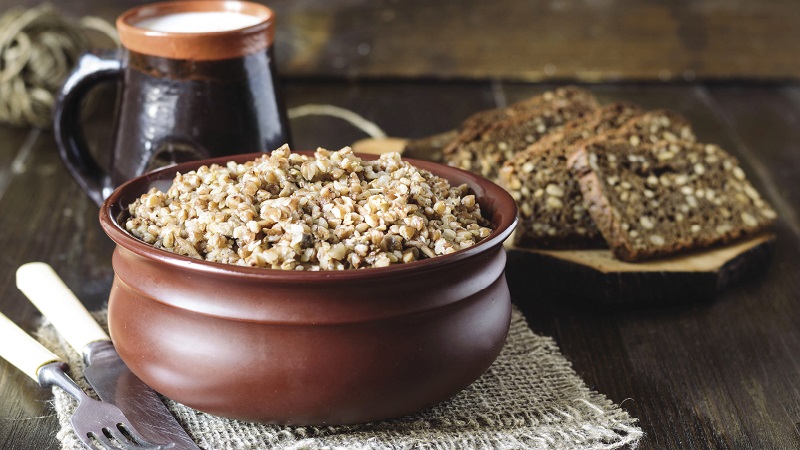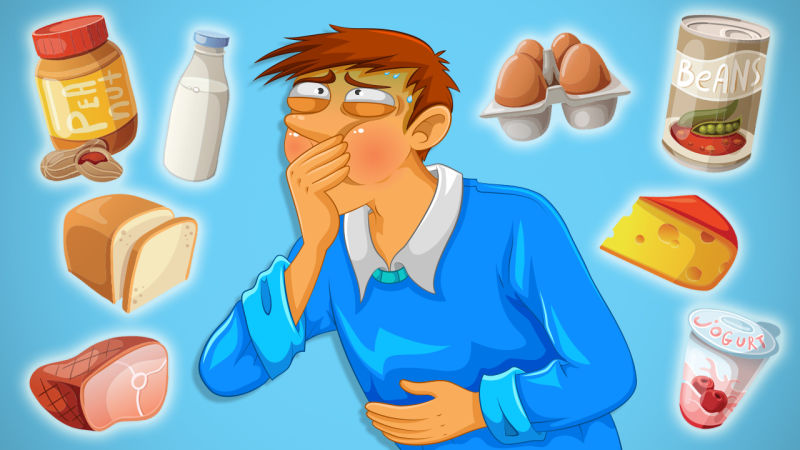How to eat buckwheat in case of poisoning and can it cause it
Food poisoning is an acute infectious-toxic disease associated with the use of poor-quality products, contaminated water and food or poisonous (plant, medicinal, chemical) substances. When establishing the fact of food intoxication, a person is provided with emergency assistance and symptomatic treatment. An important component of therapy is diet.
There is a list of foods that are introduced into the diet after the cessation of vomiting. This list includes buckwheat.
The content of the article
Useful properties of buckwheat
Buckwheat has a rich chemical composition. The content of vitamins and microelements in 100 g of cereals is indicated in the table.
| Vitamins | Macronutrients | Trace elements | |||
|---|---|---|---|---|---|
| Vitamin A, RE | 2 μg | Potassium, K | 380 mg | Aluminum, Al | 33.3 μg |
| Beta carotene | 0.01 mg | Calcium, Ca | 20 mg | Bor, B | 350 mcg |
| Vitamin B1 | 0.43 mg | Silicon, Si | 81 mg | Vanadium, V | 170 mcg |
| Vitamin B2 | 0.2 mg | Magnesium, Mg | 200 mg | Iron, Fe | 6,7 mg |
| Vitamin B4 | 54.2 mg | Sodium, Na | 3 mg | Iodine, I | 3.3 μg |
| Vitamin B5 | 0.44 mg | Sulfur, S | 88 mg | Cobalt, Co | 3.1 μg |
| Vitamin B6 | 0,4 mg | Phosphorus, Ph | 298 mg | Lithium, Li | 4.2 μg |
| Vitamin B9 | 32 μg | Chlorine, Cl | 33 mg | Manganese, Mn | 1.56 mg |
| Vitamin E | 0.8 mg | Copper, Cu | 640 μg | ||
| Vitamin H | 10 mcg | Molybdenum, Mo | 34.4 μg | ||
| Vitamin K | 7 μg | Nickel, Ni | 10.1 mcg | ||
| Vitamin PP | 7.2 mg | Rubidium, Rb | 52.5 mcg | ||
| Niacin | 4.2 mg | Selenium, Se | 5.7 mcg | ||
| Strontium, Sr | 304 μg | ||||
| Titanium, Ti | 33 μg | ||||
| Fluorine, F | 23 μg | ||||
| Chrome, Cr | 4 μg | ||||
| Zinc, Zn | 2.05 mg | ||||
| Zirconium, Zr | 35 mcg | ||||
Maintaining an optimal amount of vitamins, minerals, amino acids, proteins, fats and carbohydrates in the body is extremely important, since they all participate in important biochemical and physiological reactions. A deficiency of one of the elements adversely affects the state of health and becomes the cause of the development of pathologies.
Buckwheat is rich in flavonoids and routine, which exhibit anti-inflammatory, antioxidant and antimicrobial properties. They also serve as a good prevention of oncological diseases, protect cells from damage by free radicals. Flavonoids strengthen the vascular walls, increase their strength and elasticity, support the proper functioning of the thyroid gland and heart muscle.
Buckwheat is a valuable dietary product... It has a pleasant taste, it contains many minerals and vitamins, dietary fiber, which have a positive effect on the digestion processes. There is almost no fat in the cereal. Fiber, which buckwheat is so rich in, is absorbed by the body for 2-3 hours, fills the body with energy for a long time, without converting carbohydrates into new fat deposits.
For reference. Dietary fiber increases endurance and performance, stimulates physical activity, thereby increasing energy expenditure and reducing weight.
Regularly consuming buckwheat porridge, there is no need to fear for the health of the nervous system. B vitamins have a positive effect on brain activity, stimulate thinking processes, improve memory and concentration. Calcium and magnesium relieve insomnia, reduce stress manifestations, and participate in neuromuscular transmission.
With systematic and correct use, buckwheat supports the proper functioning of the cardiovascular system: it removes excess sugar, lowers bad cholesterol, and prevents thrombus formation.It prevents the development of atherosclerosis, hypertension, coronary heart disease, angina pectoris, stroke.
Buckwheat serves as a good prevention of diabetes mellitus and related complications, removes toxins and toxins, normalizes and controls serum sugar levels.
It is recommended to cook buckwheat porridge more often for people suffering from diseases of the musculoskeletal system. Rutin secreted from cereals has an angioprotective effect: it enhances blood circulation, strengthens capillaries, and reduces puffiness. The inclusion of buckwheat in the diet prevents the development or exacerbation of osteochondrosis, rheumatism, gout, arthritis.
Grain has a positive effect on the work of the kidneys and other organs of the urinary system, which is manifested by the removal of excess fluid from the body, getting rid of edema.
How does it affect the digestive tract
A large amount of insoluble fiber in buckwheat removes accumulated toxins and toxins from the body, regulates cholesterol and glucose in the blood, normalizes metabolism, and helps to cope with existing constipation.
Buckwheat has a positive effect on the condition and function of the digestive tract:
- protects mucous membranes;
- activates the secretion of gastric juice and bile secretion;
- maintains a balanced composition of intestinal microflora;
- protects the walls of the stomach from the aggressive effects of damaging factors (chemical, physical, mechanical);
- inhibits inflammation;
- accelerates regenerative processes;
- reduces acidity.
Buckwheat porridge will be extremely useful with erosive and ulcerative diseases of the digestive system, increased acidity of gastric juice, constipation, atrophic gastritis.

Is it possible to poison an adult or a child with buckwheat
Taking buckwheat within normal limits will not harm the body. However, prolonged and abundant consumption of low-quality cereals will damage health and cause food poisoning.
To avoid food intoxication, when buying, pay attention to the appearance of the cereal. Good quality buckwheat has a light brown whole grain. Crushed cereal grain and dark color indicate a reduced content of nutrients in the cereal.
Council. Choose a product in transparent plastic packaging, which prevents the grain from damping, allows you to evaluate the appearance of the cereal, the presence of impurities. It is better to buy premium buckwheat from proven and well-known domestic producers.
The reasons
Buckwheat poisoning is most often associated with prolonged and abundant use of low-quality buckwheat groats. Useful properties depend on the growing conditions (climate, soil type, cultivation techniques, fertilizers used), collection conditions and storage harvest.
The main causes of buckwheat poisoning:
- Insufficient crop protection and seed grain cleaning... Cereals are affected by quarantine plant varieties (more often it is hop dodder), which contain alkaloids, saponins and glycosides. These compounds are dangerous to the human body, they provoke acute infectious-toxic damage to the digestive system, and the use of large doses is fatal.
- Violation of grain storage terms... Long-term storage of the crop negatively affects the structure of the cereal, it becomes porous and accumulates toxic substances. Therefore, when buying, pay attention on the date of manufacture and the expiration date product. Moldy or musty odors indicate that the product is spoiled.
- Chinese buckwheat... The cereal crop in this country is grown in special climatic conditions with high humidity. If the grain drying technology has not been followed, the probability of food poisoning with such buckwheat increases significantly.
Signs of intoxication

From the moment of eating poor-quality food until the first signs of poisoning appear, time must pass for the poison to enter the bloodstream and have a toxic effect. The asymptomatic period lasts from 2 to 6 hours, sometimes shortened to half an hour or increased by a day.
The clinical picture of food intoxication is diverse. The most characteristic signs:
- nausea;
- repeated vomiting of food eaten;
- pain in the stomach;
- loose stools mixed with greenery, mucus, blood streaks;
- frequent bowel movements (5 to 10 times a day);
- fever;
- lethargy;
- refusal to eat;
- convulsions;
- headache and muscle pain;
- excessive sweating.
In children, food poisoning is more severe than in adults, which is associated with the characteristics of the body: low acidity of gastric juice, rapid absorption of the poison and its spread throughout the body, incomplete formation of microflora, low filtration function of the kidneys and detoxification ability of the liver.
In most cases, the condition stabilizes within 1-3 days, but painful sensations in the stomach persist for several more days.
Treatment
When establishing the fact of food intoxication, a person needs emergency assistance:
- Washing the stomach to clean waters. Apply a saline solution prepared from 1 tbsp. l. salt in 2 liters of purified drinking water or potassium permanganate. Then vomiting is artificially induced.
- Setting up a cleansing enema... Neutralizes in intestines poisons and toxins, prevents their spread throughout the body. For an enema, use a saline or soda solution, a decoction of chamomile. The procedure is performed after the first signs of intoxication appear.
- Appointment of enterosorbents... They absorb and remove harmful toxins from the body, have an antidiarrheal effect. The most popular drugs are Activated Carbon, Smecta, Sorbeks, Enterosgel. The course of treatment, depending on the indications and the severity of intoxication, lasts from three days to two weeks.
Drinking plenty of fluids is important to eliminate dehydration. It can be sweet tea, still water, saline solution. It is advisable to abstain from food for 12-24 hours. The next 3-5 days, probiotics are taken to restore the intestinal microflora.
Food poisoning in infants and young children requires immediate medical attention. Parents should always remember this and not self-medicate, entrusting the child's life and health exclusively to a specialist.
Is it possible to eat buckwheat with food poisoning for an adult or a child
A special place in the treatment of food intoxication is occupied by restorative diet... What foods are there to improve digestion, and whether buckwheat can be consumed in case of poisoning depends on the severity of the symptoms.
With frequent diarrhea and during the toxicogenic stage, buckwheat should be abandoned. Avoid other foods in the diet: fatty and spicy foods, alcohol, coffee, black bread, sweets, fruit juices, dairy products, smoked meats, fatty meats.
As is in case of poisoning

The inclusion of buckwheat in the diet during the toxicogenic period will only aggravate the overall health:
- It has a slight laxative effect, so its use is categorically unacceptable when the poisoning is accompanied by diarrhea.
- The composition of cereals contains coarse dietary fibers, which irritate the already damaged mucous membrane, thereby increasing the painful sensations in the stomach.
- Food should be light and easily digestible, and a lot of effort and energy is spent on the digestion of buckwheat porridge, which are necessary to restore the body.
After elimination of symptoms of poisoning
After the cessation of vomiting, buckwheat will be very useful, as it contains protein, which is not inferior in nutritional properties to proteins of animal origin. It saturates the body with micro- and macroelements, minerals, amino acids necessary to restore the disturbed functions of the digestive, immune, and excretory systems.
In order to prevent mechanical and thermal damage to the intestinal mucosa, it is better to cook buckwheat porridge in water without salt and oil, boil well. The dish should be liquid and warm (20-40 ° C) so it will not harm the stomach. Eat in small portions at the same time, the last meal no later than 2-3 hours before bedtime.
Council. Unleavened porridge is allowed to be combined with boiled fish, lean meats and poultry, boiled or baked vegetables.
Conclusion
Food poisoning of mild to moderate severity ends with recovery in 1-3 days. If you do not provide assistance in a timely manner, there is a possibility of dysfunction of various organs and systems.
In order to prevent the poisoning of the body with buckwheat porridge, it is important to choose cereals of proper quality, observe storage conditions and heat treatment rules, eat in small portions, and cook fresh porridge every time.